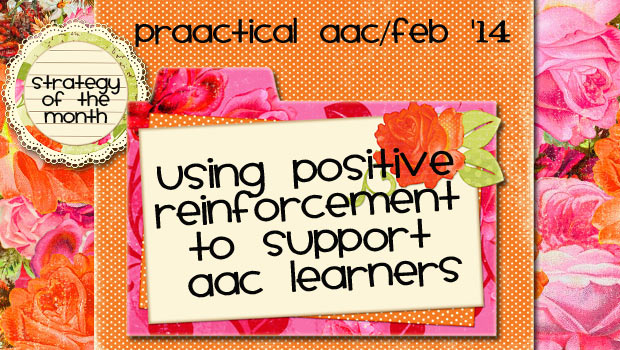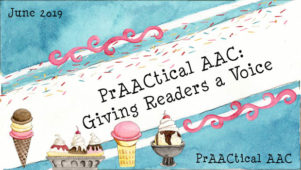Using Positive Reinforcement to Support AAC Learners

In terms of reinforcement, Jamie kept me on my toes.
- Initially, she preferred to be by herself so that she could do her own thing without any demands placed on her. Solitary time is not our favorite way to reinforce desired behavior, but it was a start. Jamie earned little bits of free time where she could have some uninterrupted play.
- Then, she seemed to like anything that she could line up. No sweat. (This is progress! We were much happier to see her desire things as opposed to the absence of company. We had lots of things that we could use and she loved the novelty of materials we presented…for short awhile).
- Quickly, that morphed into things that she could line up that had letters. Got it! (We can repurpose some alphabet puzzles/games and we’re good!).
- Then, things got interesting. One week there was an intense love of bandaids, and just after I’d made the rounds of the drugstores buying up all the cute varieties I could find, she lost interest.
- After that, it was ripping of pieces of paper (which we used in some art projects), the feel and sound of velcro (easy!), and a favorite person (Simone to the rescue!).
It wasn’t easy to keep up with her changing preferences, but at least we could figure out what Jamie liked and use that to motivate her during our time together.
Alicia presented a different kind of challenge: practically anything we offered her was met with the same level of quasi-interest. She’d take it and interact with it for a few seconds, then look bored or toss it to the floor. She had a g-tube, so food was not an option, and nothing we tried seemed to make her light up. Bet many of you recognize this prAACtical learner and have had your own Alicia experiences. Of course, preferences don’t always function as reinforcers (I like coffee, but buying me a cup isn’t enough to tempt me to do finish that stack of paperwork I’ve been putting off.) For many learners, though, they’re a great place to start.
So, what can we do in situations like Alicia’s, when nothing seems to be reinforcing? The first step may be to do a structured interview with people who know this learner well. The Reinforcer Assessment for Individuals with Severe Disabilities (Fisher, Piazza, Bowman, & Amari, 1996) is an example of one such tool that can help you conduct these interviews in a systematic way. Beyond that, an informal assessment may help your team get some answers.
Reinforcer Preference Assessment
The best reinforcement for therapy is usually that which is tailored to the specific interests and abilities of the learner. Sometimes identifying events, people, and things that are truly reinforcing is pretty straightforward. Other times, the answers aren’t clear to us but we can tap into the knowledge of family members, caregivers, and others to gather this information (and record it on a form like this). Occasionally, though, we need a process for directly assessing their preferences. There are a number of systematic approaches to determining what AAC learners prefer. This page from the Pennsylvania Department of Education reviews the basic concepts and provides a video demonstration.
Looking for more specific information on how to conduct are reinforcer preference assessment? Here are some links to peruse.
:::::::::::::::::::::::::::::::::::::::::::::::::
Fisher, W., Piazza, C., Bowman, L., & Amari, A. (1996). Integrating caregiver report with a systematic choice assessment. American Journal on Mental Retardation, 101, 15–25.
Filed under: Strategy of the Month
Tagged With: feedback, positive reinforcement
This post was written by Carole Zangari





